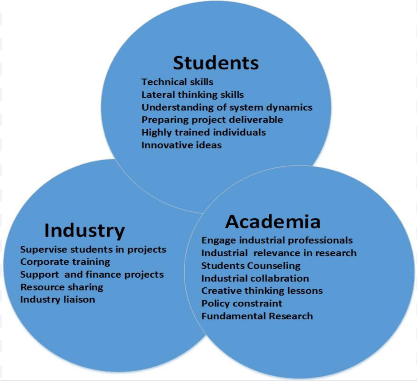
- Introduction
- The Importance of Collaboration Between Academia and Industry
- Barriers to Collaboration
- Benefits of Industry-Academia Partnerships
- Successful Models of Industry-Academia Collaboration
- Practical Steps for Creating Synergy
- Overcoming the Challenges: Solutions and Strategies
- Conclusion
Introduction
The rapid pace of technological innovation and the growing complexity of global challenges require an integrated approach to solving problems. One such approach is the collaboration between Industry and Academia. While Business Analyst Training two sectors traditionally operated independently, the increasing demand for new ideas, products, and solutions has fostered a growing need for a synergistic relationship. Industry brings practical, real-world challenges and the ability to scale solutions, while Academia offers a deep well of knowledge, cutting-edge research, and a highly skilled workforce. The synergy created from combining these strengths can result in significant advancements that benefit Society, improve industry practices, and enhance academic research. This blog explores how Industry and Academia can work together to create a synergy that accelerates innovation, fosters economic growth, and leads to meaningful societal impact. We will examine the benefits, challenges, and practical steps to ensure such collaborations succeed.
The Importance of Collaboration Between Academia and Industry
The need for collaboration between Academia and Industry has never been more pressing. In today’s interconnected world, where technological disruptions are happening at lightning speed, relying on either sector alone can limit the scope of innovation. Academic research often lays the foundation for new technologies and methodologies, but the real-world application of these ideas requires the practical know-how, investment, and infrastructure of Industry. Conversely, Academia Partnerships needs access to Business Analytics with Excel Fundamentals ideas to drive its products and services forward. By tapping into the intellectual resources and cutting-edge research found in Academia, Industry can stay ahead of the competition and contribute to solving pressing global challenges.

Some key reasons why collaboration is crucial include:
- Innovation Acceleration: Academia generates fundamental research that can inspire breakthroughs, while Industry provides the resources to bring these ideas to market.
- Workforce Development: Academic institutions equip students with knowledge and skills, while Industry provides internships, mentorships, and job opportunities that prepare graduates for the real world.
- Real-World Impact: Academic theories and models can be tested and refined in industry settings, making research more relevant to current societal and business global challenges.
In the following sections, we will explore the barriers to collaboration and discuss how Industry and Academia can overcome them.
Master Business Analyst skills by enrolling in this Business Analyst Training today.
Barriers to Collaboration
Despite the clear advantages of working together, Academia and Industry often face barriers that prevent effective collaboration. These barriers arise due to differences in culture, goals, and operational priorities, making it difficult for both sides to work in harmony.
- Cultural Differences: Academia typically values long-term, fundamental research, while Industry often prioritizes short-term results and the application of knowledge. Academia operates with a focus on theory and exploration, whereas Industry is focused on product development, marketability, and profitability. These differences can create tension, with academia perceiving industry as too commercially driven, and Industry viewing Academia as too theoretical and disconnected from real-world needs.
- Intellectual Property (IP) Concerns: Intellectual property rights are often a major sticking point in industry-academia partnerships. Industry typically wants to Definitive Guide of Working Capital Management any innovations that arise from collaboration, while academic institutions prioritize the dissemination of knowledge and often have open access policies. Negotiating IP rights and licensing agreements that satisfy both parties can be a complicated and lengthy process.
- Different Timelines: Academics may work on projects that span years or even decades, while Industry often operates with much shorter timelines. This difference can result in mismatched expectations about project completion and outcomes.
- Funding Challenges:
Funding mechanisms in Academia and Industry are often different, with Academia relying on grants and government funding, while Industry uses venture capital or internal resources.
This can create discrepancies in how both sectors approach funding for joint projects. Despite these barriers, many successful partnerships have managed to overcome global challenges by establishing clear agreements, finding common ground, and setting mutual expectations. The next section discusses the benefits of collaboration to both parties.
Enhance your knowledge in Business Analyst. Join this Business AnalystCertification Training now.
Benefits of Industry-Academia Partnerships
When successfully implemented, the benefits of collaboration between Industry and Academia are manifold, creating a win-win situation for all involved. For Academia, these partnerships offer real-world relevance by allowing researchers to work on problems with practical applications, enhancing the impact of their research. Industry partnerships also open up funding opportunities, enabling academic institutions to conduct larger, more ambitious projects. Furthermore, such collaborations provide students with career development prospects through practical experience and valuable networking opportunities, making them more attractive to future employers. For Industry, collaboration with Academia provides access to cutting-edge research, often forming the foundation for breakthrough innovations. Additionally, universities offer a rich talent pool of highly skilled individuals, which Industry can tap into for internships, collaborations, and hiring. Predictive Analytics innovation is also a key benefit, as academic research frequently focuses on foundational knowledge and technologies that can drive Industry’s future developments. Society also stands to benefit greatly from these partnerships. By working together, Academia and Industry can stimulate economic growth, foster development, and create new job opportunities. Moreover, the combined expertise and resources of both sectors are essential for addressing some of the world’s most pressing challenges, such as climate change and healthcare. This collaborative approach has the potential to generate global solutions, further emphasizing the importance of Industry-Academia partnerships. These benefits clearly highlight the importance of closer collaboration between the two sectors, but practical steps are needed to ensure these partnerships are successful.
Successful Models of Industry-Academia Collaboration
There are several models of collaboration that have proven successful in various industries. These models vary depending on the nature of the partnership, the level of involvement of each party, and the goals of the collaboration.
- Research Consortia: In research consortia, multiple companies and academic institutions collaborate on a shared research project. Business Analyst Training model is particularly effective in industries such as healthcare, energy, and technology, where large-scale research efforts are needed to tackle complex problems. Members of the consortia pool resources and expertise to conduct joint research, share data, and develop new technologies.
- Industry-Academic Research Partnerships: In these partnerships, a company collaborates with a university or research institute on a specific research project. Industry often provides funding, access to real-world problems, and technical expertise, while Academia provides the research capacity and intellectual input. An example of this is the collaboration between pharmaceutical companies and academic researchers to develop new drugs.
- Incubators and Accelerators: Many universities have established innovation hubs, incubators, and accelerators where students, faculty, and industry partners can collaborate on developing startup ideas and new technologies. These hubs often provide mentorship, funding, and resources to help bring academic research into the marketplace.
- Internship and Fellowship Programs: Industry and Academia can also collaborate through internship programs that allow students to gain real-world experience while contributing to the development of new technologies and solutions. These programs benefit both students and companies, as they allow companies to scout talent early while providing students with valuable industry experience.
- Establish Clear Goals and Expectations: Before embarking on a partnership, both parties should clearly define the objectives and expectations. What are the goals of the collaboration? What outcomes are expected? Clear agreements on deliverables, timelines, and resources will help avoid misunderstandings later on.
- Create a Formal Partnership Framework: Having a formal structure in place for the collaboration is essential. This could be in the form of a memorandum of understanding (MOU) or a formal contract that outlines the roles, responsibilities, and expectations of each party.
- Foster Open Communication: Maintaining open lines of communication is vital for any successful partnership. Regular meetings, progress reports, and ECBA vs CCBA vs CBAP of data and ideas can help ensure that both Academia and Industry are aligned on the project’s goals.
- Emphasize Mutual Benefit: Both sides should understand the value of the collaboration and be committed to ensuring that the benefits are shared equally. This includes not only financial benefits but also intellectual property rights, career development, and societal impact.
Want to lead in Business Analyst? Enroll in ACTE’s Business Intelligence Master Program Training Course and start your journey today!
Practical Steps for Creating Synergy
For Academia and Industry to collaborate successfully, certain practical steps need to be taken. Here are some ways to create synergy between the two sectors:

Preparing for a job interview? Explore our blog on Business Analyst Interview Questions and Answers!
Overcoming the Challenges: Solutions and Strategies
While there are certainly challenges to collaboration between Industry and Academia, these can be mitigated through careful planning and a commitment to mutual benefit. One of the key obstacles is addressing cultural differences. Both sectors must be willing to understand and respect each other’s distinct approaches. Industry should recognize the importance of long-term research and its potential for future breakthroughs, while Academia should appreciate the need for research to have real-world applications. One effective solution is creating cross-disciplinary teams that can help bridge the gap and foster mutual understanding. Another challenge is managing intellectual property (IP), which can be a significant concern in joint collaborations. To address this, clear agreements should be established from the outset regarding the ownership, use, and Tableau vs Looker of any intellectual property generated. This can involve negotiating licensing agreements and defining how royalties will be shared, ensuring that both parties feel secure and fairly compensated. Aligning timelines can also present difficulties, as the pace of work in Industry and Academia often differs. Academic research typically follows longer timelines, while Industry faces commercial pressures that demand quicker results. To overcome this, realistic expectations should be set at the beginning of the project. Both parties must make an effort to understand each other’s constraints—Academia should acknowledge the need for speed in commercial contexts, and Industry should allow sufficient time for thorough academic exploration. By addressing these challenges through thoughtful strategies, both Academia and Industry can create a stronger foundation for collaboration and achieve mutually beneficial outcomes.
Business Analyst Sample Resumes! Download & Edit, Get Noticed by Top Employers! DownloadConclusion
The collaboration between Industry and Academia is crucial to advancing innovation, driving economic growth, and solving complex societal problems. By creating a strong synergy between these two sectors, Business Analyst Training can benefit from groundbreaking research, new technologies, and a skilled workforce ready to tackle the challenges of the future. For such collaborations to thrive, both sides must be willing to navigate the barriers and embrace the opportunities that come from working together. With clear goals, open communication, and a shared commitment to mutual benefit, Academia and Industry can create a powerful partnership that drives progress in every field.





